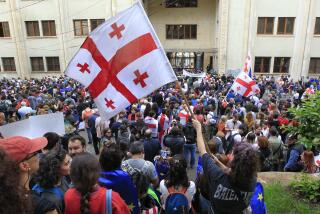In the Baltics, a Nervous Eye on Moscow : Actions Regarding Republics Will Help Show Limits of <i> Perestroika</i>
- Share via
A moment of truth is hurtling down on the Soviet Union. Ever since the Supreme Soviet announced plans to amend the nation’s constitution, Armenians and Azerbaijanis have been up in arms over proposed amendments concerning territorial matters.
An even more fundamental challenge to perestroika has arisen in the Baltic republics, where 7.5 million residents of Estonia, Latvia and Lithuania have been struggling to define their place in President Mikhail S. Gorbachev’s new, improved Soviet Union.
Estonia has been the vanguard of this movement, testing perestroika in at least three ways: It was an independent country with a democratic tradition as recently as 1940, when it was conquered, in effect, by Josef Stalin; its economy is among the most productive of the 15 Soviet republics, and its native population is increasingly worried about becoming a minority in its own land. (As new jobs in Estonia draw Russians into the republic, the Estonian population continues to shrink. In 1939 about 90% of the people were Estonian; today that figure is about 60%.)
After Tuesday the boundaries of perestroika will be clearer. That’s when the Supreme Soviet will vote on several draft amendments to the constitution that are intended to expand its own (i.e., Moscow’s) powers at the expense of the Soviet republics.
Like Estonia, Latvia and Lithuania also are opposed to further encroachment on their already fragile sovereignty. By mid-November, more than 3.5 million people had signed petitions denouncing the constitutional amendments.
At an extraordinary meeting on Nov. 18, the Estonian parliament rejected Moscow’s proposed changes and claimed veto power over such legislation in its own territory. Despite overwhelming popular support for unity with Estonia, the parliaments of Lithuania and Latvia chose the politics of prudence and postponed a decision on the constitutional amendments.
On Nov. 21, Pravda denounced the Baltic initiatives and accused Estonia of making demands that could “undermine the very basis of the existence of the U.S.S.R.” Moscow clearly sees the Baltic uproar as nothing less than a display of dangerous extremism that can only threaten Gorbachev’s mandate.
Until recently, Estonians were among Gorbachev’s most ardent supporters. “Now the country is twisting and turning in joy and in pain, and nobody knows what will come next,” according to one Estonian activist. “All that seems certain is that this November will decide the fate of our people.”
It will indeed. The players, both in Tallinn and in Moscow, face a difficult choice of moves. One extreme is the complete resurrection of Estonian independence after nearly 50 years of Soviet rule. This seems unlikely, considering the economic importance of the Estonian republic to the Soviet Union.
The other is a Budapest or Prague-style intervention, as Moscow brings glasnost to a halt. But this is unlikely, too. Political crackdown is bad for economic enterprise. Since Estonian skills and resources are crucial to the success of perestroika , any threat to Baltic enterprise is therefore a threat to Gorbachev’s entire program of reform.
This makes it likely that the moment of truth will end somewhere in between. The constitutional commission of the Supreme Soviet has already responded to Baltic dissatisfaction, at least in form, with more than 40 amendments to the proposed constitutional changes.
American Sovietologist Seweryn Bialer has noted that the significance of Gorbachev’s reform effort lies not in its absolute success or failure, but rather in the magnitude of its progress. In the same way, the events of this month ought not to be taken as a test of perestroika’s success or failure. Despite fundamental problems, the Soviet Union of 1988 is far different from that of early 1985.
In three years Gorbachev has changed the internal workings of the country in ways unimaginable just a short while ago. He has begun a fundamental reform of the Communist Party, gone a long way toward revitalizing the stagnating cultural life and brought a taste of free enterprise to the Soviet Union. Yet he still faces unbroken resistance from Politburo conservatives, bureaucratic resistance to economic change and ethnic challenges on the southern border at least as volatile as anything in the Baltic.
Tuesday’s vote could therefore be a watershed. Depending on the outcome of the vote, it could mark the first day of the rest of perestroika. Or it could confirm that the process has already reached its limits.
More to Read
Sign up for Essential California
The most important California stories and recommendations in your inbox every morning.
You may occasionally receive promotional content from the Los Angeles Times.













